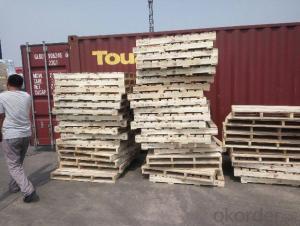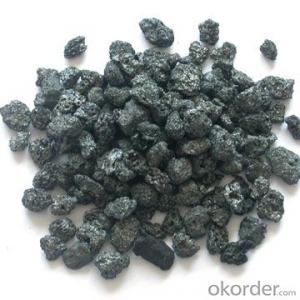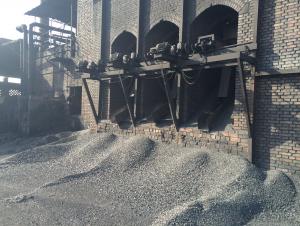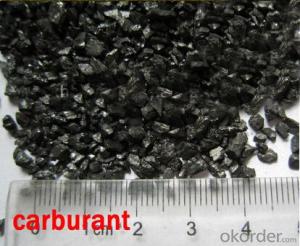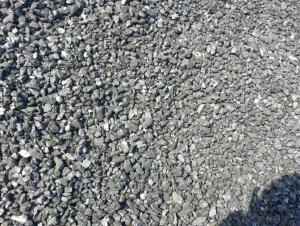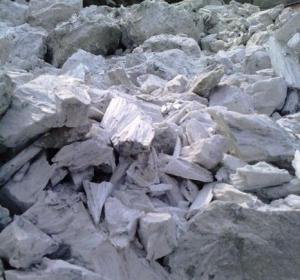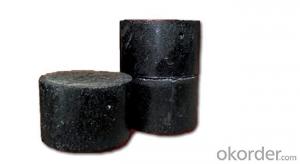Calcined Petroleum Coke as Injection Coke for Foundry Mills
- Loading Port:
- Tianjin
- Payment Terms:
- TT OR LC
- Min Order Qty:
- 20.5
- Supply Capability:
- 1015 m.t./month
OKorder Service Pledge
OKorder Financial Service
You Might Also Like
Intrduction
Carbon additive to ningxia production of anthracite as raw material, after washing, crushing, high temperature calcination, filter, etc. Craft refined and become.This is after the anthracite calcination generated high carbon content and low volatile component of the new product, is an ideal raw material to make steel.
Calcined Petroleum Coke comes from delayed coke which extracted from oil refinery. Although Calcined Petroleum Coke contains a little bit higher level of sulfur and nitrogen than pitch coke, the price advantage still makes it widely used during steel-making and founding as a kind of carbon additive/carburant.
Features
In the smelting process for reducing agent. Performance: replace the traditional oil carbon additive, decrease the cost of steelmaking. Features: low ash. low sulfur,low phosphorus, high calorific value. High ratio resistance,high mechanical strength,high chemistry activity. It is mainly used for metallurgy reductant inoculants, casting, refractory materials, machinery, electronics and other fields.Good quality
1) high absorption rate, it can be absorbed up to 90%.
2) absorbed more quickly than other carbon additive; no residue remains in furnace.
3) low Sulfur, the lowest can reach below 0.20%; low nitrogen, normally below 200ppm (0.02%)
Specifications
CPC | |||
F.C.% | 98.5MIN | 98.5MIN | 98MIN |
ASH % | 0.8MAX | 0.8MAX | 1MAX |
V.M.% | 0.7 MAX | 0.7 MAX | 1 MAX |
SULFUR % | 0. 5MAX | 0. 7MAX | 1MAX |
MOISTURE % | 0.5MAX | 0.5MAX | 1MAX |
Pictures


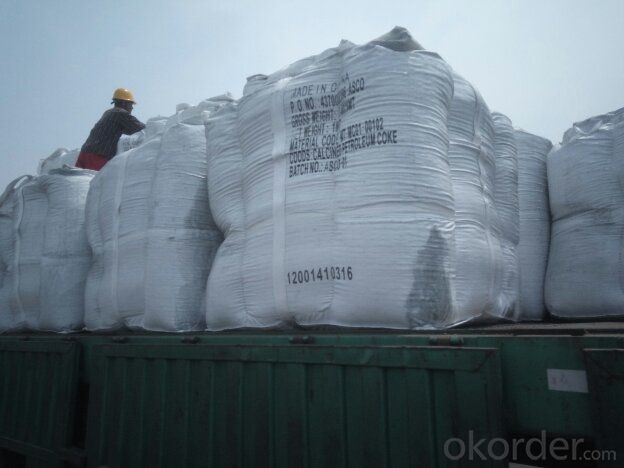

FAQ:
(1)CPC could be as fuel
Petroleum coke is a material relatively low in cost and high in heat value and carbon content with good chemical stability, making it an efficient and costeffective fuel for producing metal, brick and related products.
(2)CPC could be as Graphite Electrodes
Graphite can be produced from lowsulfur needle petroleum coke, which must be heated above 5,432 degrees Fahrenheit.
(3)CPC could be as Anodes
Calcined petroleum coke, often low in sulfur and metallic impurities, is used to make anodes for
the smelting industry.Calcined petroleum coke is mixed with coal tar pitch in the production of
anodes.
- Q:What does carbon cloth tonnage mean?
- Carbon cloth tonnage is illegal: mean a square centimeter of sectional area of carbon cloth tension of tonnage. Meaning that the carbon cloth rolled into a solid "rod" if the cross-sectional area of the bar is 1 cm, the maximum tension tonnage it bear -- carbon cloth tonnage.
- Q:What are the advantages of carbon-based fuel cells?
- There are several advantages of carbon-based fuel cells that make them a promising technology for the future. Firstly, carbon-based fuel cells have a higher energy density compared to conventional batteries. This means that they can store and deliver more energy per unit weight, allowing for longer operating times and greater power output. This is particularly beneficial in applications where high power density and long-range capabilities are required, such as electric vehicles. Secondly, carbon-based fuel cells have a faster refueling time compared to conventional batteries. While recharging a battery can take hours, refueling a carbon-based fuel cell can be done in a matter of minutes. This is a significant advantage, as it reduces the downtime for refueling and enables a more convenient and efficient usage of the fuel cell technology. Furthermore, carbon-based fuel cells have a lower environmental impact compared to traditional combustion engines. When carbon-based fuel cells are used, the only byproducts are water and heat, making them a clean and environmentally friendly energy source. This is in contrast to internal combustion engines, which produce harmful emissions that contribute to air pollution and climate change. Another advantage of carbon-based fuel cells is their versatility and compatibility with existing infrastructure. They can be easily integrated into existing energy systems, allowing for a smooth transition from fossil fuels to cleaner energy sources. This compatibility makes carbon-based fuel cells a viable option for various applications, ranging from portable electronics to residential power generation. Lastly, carbon-based fuel cells have the potential to contribute to energy independence. As carbon-based fuels can be produced from renewable sources, such as biomass or waste, they offer a sustainable and domestically sourced energy solution. This reduces dependence on foreign oil and enhances energy security for countries. In conclusion, the advantages of carbon-based fuel cells include higher energy density, faster refueling time, lower environmental impact, compatibility with existing infrastructure, and potential for energy independence. With these benefits, carbon-based fuel cells have the potential to revolutionize the energy landscape and provide a sustainable and efficient alternative to conventional energy sources.
- Q:What are the differences between the three carburizing, nitriding and carbonitriding? What are the different effects on the material?
- Without quenching, it can have high hardness, wear resistance, fatigue resistance, a certain degree of corrosion of the river, and the deformation is very smallCarbonitriding is also called cyaniding.
- Q:What are the impacts of carbon emissions on marine life?
- Carbon emissions, particularly in the form of carbon dioxide (CO2) released from burning fossil fuels, have significant impacts on marine life. One of the primary effects is ocean acidification, which occurs when excess CO2 is absorbed by seawater, leading to a decrease in pH levels. This acidification can have detrimental effects on marine organisms, especially those with calcium carbonate shells or skeletons, such as corals, mollusks, and some plankton. As the pH levels decrease, it becomes harder for these organisms to build and maintain their shells. This can result in reduced growth rates, weakened shells, and increased vulnerability to predation and disease. Additionally, the dissolution of calcium carbonate shells due to ocean acidification can disrupt the entire food chain, as many organisms rely on these shells for protection or as a food source. Furthermore, carbon emissions contribute to global warming, leading to rising sea temperatures. Warmer waters can cause coral bleaching, a phenomenon where corals expel the colorful algae living within their tissues, resulting in the loss of their main food source and leading to their eventual death. Coral reefs are vital ecosystems that support a diverse array of marine life, and their decline has far-reaching consequences on biodiversity and coastal communities that rely on them for tourism and fisheries. The impacts of carbon emissions on marine life extend beyond individual species and ecosystems. Climate change, driven by carbon emissions, can disrupt ocean currents, alter weather patterns, and cause changes in nutrient availability. These changes can affect the distribution and abundance of marine organisms, leading to shifts in species composition and potential loss of biodiversity. It is worth noting that the impacts of carbon emissions on marine life are interconnected with other stressors such as overfishing, pollution, and habitat destruction. These combined pressures exacerbate the vulnerability of marine ecosystems and increase the risks of irreversible damage. To mitigate the impacts of carbon emissions on marine life, reducing greenhouse gas emissions is crucial. Transitioning to cleaner and renewable energy sources, improving energy efficiency, and adopting sustainable practices can help slow down the rate of ocean acidification and global warming. Additionally, protecting and restoring marine habitats, implementing sustainable fishing practices, and reducing pollution can enhance the resilience of marine ecosystems and promote the recovery of marine life.
- Q:How much is a ton of carbon fiber? How much difference is made between domestic and imported?
- To 12K carbon fiber, for example, domestic prices between 16~17 million, imports of Dongli carbon fiber prices between 27~29 million.
- Q:Search for a summary of the importance of carbon in life. If you write well, you can add points,
- People familiar with the organic carbon material more use in daily life and industrial and agricultural production, mainly on gasoline, diesel, kerosene, liquefied gas, natural gas, chemical solvents and fire extinguishing agents such as carbon tetrachloride, carbohydrates (rice, wheat, corn, sorghum, sweet potatoes, potatoes, sugar, fruit, vegetables, paper etc.) chemical fiber, cotton, wood, etc. not all examples.In short, without carbon and its compounds on earth, humans and all living things can not survive and develop, or the earth is a lifeless sphere with only rocks and soil
- Q:What are the consequences of increased carbon emissions on political stability?
- Political stability can be significantly affected by the increase in carbon emissions. Environmental challenges and natural disasters are intensified as a result. The frequency and intensity of extreme weather events, such as hurricanes, droughts, and flooding, are increased due to carbon emissions contributing to global warming. These disasters have the potential to displace communities, destroy infrastructure, and result in loss of life, all of which can destabilize societies. Furthermore, the economic consequences of increased carbon emissions can also lead to political instability. Climate change affects vital sectors such as agriculture, water resources, and energy production, causing economic disturbances, unemployment, and rising food prices. These hardships can fuel social unrest, protests, and even conflicts, particularly in countries heavily reliant on these sectors for their livelihoods. Moreover, increased carbon emissions can exacerbate existing social and political tensions. Vulnerable populations, including marginalized groups and communities in developing countries, are disproportionately affected by climate change. This inequality can worsen social disparities, increase social unrest, and result in political instability as marginalized communities demand action and justice. Additionally, addressing the global issue of climate change requires international cooperation and agreements. However, increased carbon emissions can strain diplomatic relations, especially between countries with differing views on climate action. Disagreements over carbon reduction targets, carbon trading mechanisms, and financial contributions can create diplomatic tensions and hinder global cooperation, ultimately impacting political stability. In conclusion, the consequences of increased carbon emissions have wide-ranging effects on political stability. From environmental challenges and natural disasters to economic disturbances and social tensions, carbon emissions strain societies and governments. To ensure political stability, it is crucial to make global efforts to reduce carbon emissions and mitigate the impacts of climate change.
- Q:How is carbon used in the production of filters?
- Due to its unique properties, carbon finds common usage in filter production. One of the primary applications of carbon in filters is its capacity to adsorb impurities and contaminants, attracting and retaining them. This is attributed to carbon's extensive surface area and multitude of minute pores, enabling it to effectively capture and eliminate particles, chemicals, and odors from substances like air, water, and more. In air filters, carbon is frequently combined with other materials, such as activated charcoal, to form activated carbon filters. These filters are utilized to eradicate air pollutants, allergens, and odors. The activated carbon adsorbs the contaminants, entrapping them within its porous structure and ultimately enhancing the overall air quality. In water filters, carbon can be employed in diverse forms, like granular activated carbon (GAC) or carbon block filters. GAC filters are widely utilized in household water filtration systems and are adept at eliminating chlorine, volatile organic compounds (VOCs), pesticides, and other chemicals. Conversely, carbon block filters are produced by compressing activated carbon into a solid block, thus providing a greater surface area and superior filtration efficiency. Apart from air and water filters, carbon is also utilized in various other filter types, such as those utilized in industrial processes, gas masks, and respirators. The versatility of carbon in filtering applications stems from its capability to adsorb a broad range of contaminants and its high adsorption capacity. Its inclusion in filters aids in enhancing the quality and safety of the substances undergoing filtration, rendering it an indispensable material in numerous filtration processes.
- Q:What are the benefits of carbon-neutral technologies?
- Carbon-neutral technologies play a crucial role in addressing climate change and creating a sustainable future due to their numerous benefits. Firstly, these technologies effectively reduce greenhouse gas emissions, especially carbon dioxide, which is the primary contributor to global warming. By transitioning to carbon-neutral technologies, we can significantly decrease our carbon footprint and mitigate the adverse effects of climate change. Secondly, carbon-neutral technologies promote energy efficiency and the conservation of resources. Many of these technologies, such as solar and wind power, utilize endless and easily accessible natural resources. This reduces our dependence on finite fossil fuels, thus safeguarding the environment and enhancing energy price stability. Moreover, embracing carbon-neutral technologies leads to improved air quality and public health. Conventional energy sources like coal and oil contribute to air pollution and have detrimental effects on human health, including respiratory and cardiovascular issues. By adopting cleaner technologies, we can reduce air pollution and enhance the well-being of individuals and communities. Additionally, carbon-neutral technologies can stimulate economic growth and create job opportunities. The development, installation, and maintenance of renewable energy infrastructure require skilled workers, leading to job creation and economic development. This transition also reduces reliance on imported energy sources, thereby enhancing energy independence and national security. Lastly, by embracing carbon-neutral technologies, we can demonstrate global leadership and contribute to international efforts in combating climate change. Countries that adopt these technologies serve as role models for others and encourage global cooperation in reducing greenhouse gas emissions. In conclusion, carbon-neutral technologies offer a wide range of benefits that are multidimensional. They not only help mitigate climate change and reduce greenhouse gas emissions but also promote energy efficiency, enhance air quality, stimulate economic growth, and contribute to global efforts in creating a sustainable future.
- Q:What are the consequences of increased carbon emissions on economic stability?
- Increased carbon emissions have significant consequences on economic stability. Firstly, the costs associated with climate change impacts such as extreme weather events, rising sea levels, and damage to infrastructure can burden economies, leading to increased expenditures for adaptation and recovery. Additionally, carbon-intensive industries may face regulatory measures and higher costs, impacting their competitiveness and potentially leading to job losses. The need for transitioning to cleaner energy sources and implementing carbon pricing mechanisms can also entail upfront investments and adjustment costs for businesses. Finally, the potential disruption of global supply chains due to climate-related events can disrupt trade and negatively impact economic stability. Overall, increased carbon emissions pose risks to economic stability by exacerbating climate change impacts and necessitating costly adjustments.
1. Manufacturer Overview |
|
|---|---|
| Location | |
| Year Established | |
| Annual Output Value | |
| Main Markets | |
| Company Certifications | |
2. Manufacturer Certificates |
|
|---|---|
| a) Certification Name | |
| Range | |
| Reference | |
| Validity Period | |
3. Manufacturer Capability |
|
|---|---|
| a)Trade Capacity | |
| Nearest Port | |
| Export Percentage | |
| No.of Employees in Trade Department | |
| Language Spoken: | |
| b)Factory Information | |
| Factory Size: | |
| No. of Production Lines | |
| Contract Manufacturing | |
| Product Price Range | |
Send your message to us
Calcined Petroleum Coke as Injection Coke for Foundry Mills
- Loading Port:
- Tianjin
- Payment Terms:
- TT OR LC
- Min Order Qty:
- 20.5
- Supply Capability:
- 1015 m.t./month
OKorder Service Pledge
OKorder Financial Service
Similar products
New products
Hot products
Hot Searches
Related keywords
